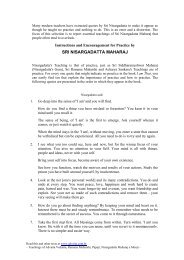
The notebook contains all the other works included in the Tamil parayana, and in the present book all the works copied by Bhagavan in the notebook are reproduced except Sri Ramana Stuti Panchakam and the works of Sivaprakasam Pillai. It appears that Sri Bhagavan copied all these verses for Swami Sivananda sometime in the early 1940s, and hence this notebook does not contain Ekatma Panchakam and Atma Bodham, which were composed by Sri Bhagavan in 19 respectively. And on page thirteen, above his verse 'karunar navamayk.' (which means, 'This is Arunachala Siva, who, being the ocean of grace, bestows liberation when meditated upon', and which is intended to be written below a picture of Arunachala) he drew a small sketch of the holy hill Arunachala. Since his attendant did not know any language or script other than Tamil, Sri Bhagavan also transliterated in Tamil script all the verses in Sanskrit, Telugu and Malayalam. Since no work was ever too small or insignificant for Sri Bhagavan to attend to, he painstakingly copied all the verses in his small and neat handwriting in a pocket-size notebook which he himself had bound. However, Swami Sivananda, who was an attendant of Sri Bhagavan during the 1940s, knew that he could not copy all the verses without making many mistakes, so he requested Sri Bhagavan to copy them for him. This is a paragraph from page 109: All the above-mentioned works were copied in the ashram parayana notebook and any devotees who were interested to join in the parayana would copy the verses in their own notebooks. The Thayumanavar verses are printed in this 2002 edition, but the Sivprakasam Pillai verses are not. This information was not printed in the first edition.

I found the information I posted yesterday in a 2002 reprint of this book, appendix one, starting on page 107. If anyone is interested, I can also post the selections from Sivaprakasam Pillai. Venkatasubramanian, Robert Butler and myself. The translations of all the other verses are by T. Since it bears a remarkable resemblance to Ulladu Narpadu, verse 30, I have put the Collected Works version of that verse at the end in bold type. Bhagavan once said that this final verse was his favourite Thayumanavar verse. The first nine are from Akarabuvanam-Chidambara Rahasyam, verses 15-23. Here are the ten verses that Bhagavan selected from Thayumanavar, a Tamil poet-saint who lived between AD 17. The Tamil renderings of the verses from Vivekachudamani were composed by Sri Bhikshu Sastrigal, and the Tamil renderings of the verses from Sivananda Lahiri were composed by an unknown devotee.ĭay twelve: Sri Ramana Stuti Panchakam by Sathyamangala Venkataramaiyer.ĭay thirteen: Sri Ramana Sadguru Malai and Deva Malai, verses 1-28, by Sivaprakasam Pillai.ĭay fourteen: Sri Ramana Deva Malai, verses 29-42, and Vinnappam by Sivaprakasam Pillai.ĭay fifteen: Sri Ramana Padamalai by Sivaprakasam Pillai, and verses in praise of Tiruchuzhi by Manikkavachagar and Sundaramurti. These are not included in The Works of Bhagavan Sri Ramana Maharshi in his own Handwriting because they were composed by Bhagavan after he had written out the notebook for Sivananda Swami.ĭay eleven: selected verses in Sanskrit and Tamil from Vivekachudamani, Sivananda Lahari and Thayumanavar.

Bhagavan wrote out all the parayana works for Sivananda Swami because Sivananda Swami felt that he could not do the work himself without making a lot of mistakes.ĭay one: Arunachala Tevarams by Jnanasambandhar, Tirunavukkavasu (Appar) and Sundaramurti.ĭay two: Sri Arunachala Tattuvam, Mahatmyam and Aksharamanamalai.ĭay three: Sri Arunachala Navamanimalai, Patikam, Ashtakam, Appala Pattu and Atma Vidya by Bhagavan.ĭay four: Upadesa Undiyar (Tamil) and Upadesa Saram in Malayalam, Telugu and Sanskrit.ĭay five: Ulladu Narpadu Kalivenba and Anubandham.ĭay six: Sat Darsanam (the Malayalam version of Ulladu Narpadu) with Anubandham.ĭay eight: Atma-Sakshatkara Prakaranam, Guru Stuti and Hastamalakam.ĭay nine: Sri Bhagavad Gita Saram in Tamil, Malayalam and Sanskrit.ĭay ten: Atma-Bodham and Ekatma Panchakam. This book is actually a facsimile of a notebook that was used by Sivananda Swami, one of Bhagavan’s attendants, for chanting. Here is a list that I found on page 108 of The Works of Bhagavan Sri Ramana Maharshi in his own Handwriting. As I mentioned before, there was a fifteen-day cycle of chanting, with different works being chanted on each of those fifteen days. However, not all the items were in Tamil portions of it were in Telugu, Malayalam and Sanskrit. The first thing to note is that it was called ‘Tamil parayana’ to distinguish it from the Veda parayana which also took place in Bhagavan’s presence every day. I have located a list of the items, which I will give later in today’s post.

Over the last few days a couple of readers have asked me about the contents of the Tamil parayana that was chanted during Bhagavan’s lifetime.


 0 kommentar(er)
0 kommentar(er)
